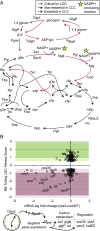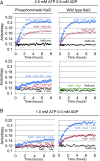Genome-wide fitness assessment during diurnal growth reveals an expanded role of the cyanobacterial circadian clock protein KaiA
- PMID: 29991601
- PMCID: PMC6064986
- DOI: 10.1073/pnas.1802940115
Genome-wide fitness assessment during diurnal growth reveals an expanded role of the cyanobacterial circadian clock protein KaiA
Abstract
The recurrent pattern of light and darkness generated by Earth's axial rotation has profoundly influenced the evolution of organisms, selecting for both biological mechanisms that respond acutely to environmental changes and circadian clocks that program physiology in anticipation of daily variations. The necessity to integrate environmental responsiveness and circadian programming is exemplified in photosynthetic organisms such as cyanobacteria, which depend on light-driven photochemical processes. The cyanobacterium Synechococcus elongatus PCC 7942 is an excellent model system for dissecting these entwined mechanisms. Its core circadian oscillator, consisting of three proteins, KaiA, KaiB, and KaiC, transmits time-of-day signals to clock-output proteins, which reciprocally regulate global transcription. Research performed under constant light facilitates analysis of intrinsic cycles separately from direct environmental responses but does not provide insight into how these regulatory systems are integrated during light-dark cycles. Thus, we sought to identify genes that are specifically necessary in a day-night environment. We screened a dense bar-coded transposon library in both continuous light and daily cycling conditions and compared the fitness consequences of loss of each nonessential gene in the genome. Although the clock itself is not essential for viability in light-dark cycles, the most detrimental mutations revealed by the screen were those that disrupt KaiA. The screen broadened our understanding of light-dark survival in photosynthetic organisms, identified unforeseen clock-protein interaction dynamics, and reinforced the role of the clock as a negative regulator of a nighttime metabolic program that is essential for S. elongatus to survive in the dark.
Keywords: circadian clock; cyanobacteria; diurnal physiology; photosynthesis; transposon sequencing.
Conflict of interest statement
The authors declare no conflict of interest.
Figures








Similar articles
-
The circadian oscillator in Synechococcus elongatus controls metabolite partitioning during diurnal growth.Proc Natl Acad Sci U S A. 2015 Apr 14;112(15):E1916-25. doi: 10.1073/pnas.1504576112. Epub 2015 Mar 30. Proc Natl Acad Sci U S A. 2015. PMID: 25825710 Free PMC article.
-
Diversity of KaiC-based timing systems in marine Cyanobacteria.Mar Genomics. 2014 Apr;14:3-16. doi: 10.1016/j.margen.2013.12.006. Epub 2014 Jan 3. Mar Genomics. 2014. PMID: 24388874 Review.
-
Architecture and mechanism of the central gear in an ancient molecular timer.J R Soc Interface. 2017 Mar;14(128):20161065. doi: 10.1098/rsif.2016.1065. J R Soc Interface. 2017. PMID: 28330987 Free PMC article. Review.
-
The Kai-Protein Clock-Keeping Track of Cyanobacteria's Daily Life.Subcell Biochem. 2019;93:359-391. doi: 10.1007/978-3-030-28151-9_12. Subcell Biochem. 2019. PMID: 31939158 Review.
-
The role of the Synechocystis sp. PCC 6803 homolog of the circadian clock output regulator RpaA in day-night transitions.Mol Microbiol. 2018 Dec;110(5):847-861. doi: 10.1111/mmi.14129. Epub 2018 Oct 23. Mol Microbiol. 2018. PMID: 30216574
Cited by
-
Altered Carbon Partitioning Enhances CO2 to Terpene Conversion in Cyanobacteria.Biodes Res. 2022 Feb 7;2022:9897425. doi: 10.34133/2022/9897425. eCollection 2022. Biodes Res. 2022. PMID: 37850123 Free PMC article.
-
Dynamic Inventory of Intermediate Metabolites of Cyanobacteria in a Diurnal Cycle.iScience. 2020 Oct 20;23(11):101704. doi: 10.1016/j.isci.2020.101704. eCollection 2020 Nov 20. iScience. 2020. PMID: 33196027 Free PMC article.
-
Synechocystis KaiC3 Displays Temperature- and KaiB-Dependent ATPase Activity and Is Important for Growth in Darkness.J Bacteriol. 2020 Jan 29;202(4):e00478-19. doi: 10.1128/JB.00478-19. Print 2020 Jan 29. J Bacteriol. 2020. PMID: 31767776 Free PMC article.
-
Are There Circadian Clocks in Non-Photosynthetic Bacteria?Biology (Basel). 2019 May 22;8(2):41. doi: 10.3390/biology8020041. Biology (Basel). 2019. PMID: 31121908 Free PMC article. Review.
-
Diurnal Regulation of In Vivo Localization and CO2-Fixing Activity of Carboxysomes in Synechococcus elongatus PCC 7942.Life (Basel). 2020 Aug 29;10(9):169. doi: 10.3390/life10090169. Life (Basel). 2020. PMID: 32872408 Free PMC article.
References
-
- Woelfle MA, Ouyang Y, Phanvijhitsiri K, Johnson CH. The adaptive value of circadian clocks: An experimental assessment in cyanobacteria. Curr Biol. 2004;14:1481–1486. - PubMed
-
- Yerushalmi S, Yakir E, Green RM. Circadian clocks and adaptation in Arabidopsis. Mol Ecol. 2011;20:1155–1165. - PubMed
-
- Dodd AN, et al. Plant circadian clocks increase photosynthesis, growth, survival, and competitive advantage. Science. 2005;309:630–633. - PubMed
Publication types
MeSH terms
Substances
Grants and funding
LinkOut - more resources
Full Text Sources
Other Literature Sources

